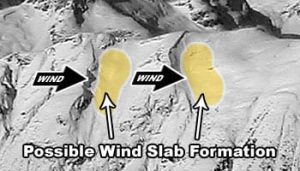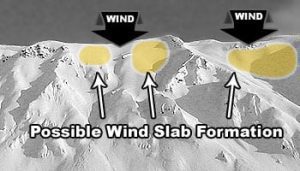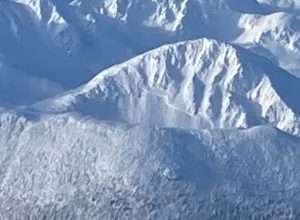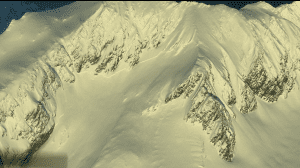Haines Avalanche Center
Above 2,500ftModerate
1,500 to 2,500ftModerate
Below 1,500ftModerate
Degrees of Avalanche Danger
Avalanche Problems
Problem 1
Aspect: All aspects
Elevation: Tree-line and above
Bottom Line:
SE winds over the weekend, and then NW winds this week have formed wind slabs below ridges and terrain features. This problem will be widespread in exposed areas. Careful snowpack evaluation, cautious route finding and conservative decision making are essential. Human-triggered avalanches are possible 1-3′ deep.
Travel Advice:
- Avoid steep wind-loaded slopes!
- Stick to slopes less steep than 30-degrees while in the alpine. If you choose to venture onto steeper slopes, carefully evaluate them by digging, probing, and testing them. Reduce risk exposure and travel one-at-a-time.
- Look for blowing snow, shooting cracks, whumphing or collapsing that indicate a stiffer slab over weaker snow.
- Wind slabs can break above you
- Use other visual clues such as scoring, wind textured snow, or phat loaded pillows to identify locations of the where snow has drifted in and avoid these areas


Likelihood:
- Almost Certain
- Very Likely
- Likely
- Possible
- Unlikely
Size:
- Historic
- Very Large
- Large
- Small
Trend
- Increasing
- Steady
- Decreasing
Avalanche Activity
First Photo: Deep slab natural avalanche that occurred roughly 1/29 in the Lutak Zone. This slide may have run on a deep rain crust near the ground (it went all the way to ground in spots).
Last two photos: From 1/29 to 2/1, several reports came in of recent avalanches in the alpine of the Transitional Zone. The common characteristics of these slides were wide propagation, and failing 2-5ft deep at the interface below the wind slabs from last week’s atmospheric river. We have strong reason to suspect these slides occurred on a buried surface hoar layer from 1/20. They happened on all aspects, at elevations from 3000 – 5000ft, and all were in wind sheltered areas below ridges, features, and starting zones. Slide were observed in the Transitional and Lutak zones, but the Lutak slides appear to be on different layers.
Weather
Forecast:
Light snowfall begins Thursday morning, and will become heavy by nightfall. 10-16″ of new snow is expected by midday Friday. Sometime Friday afternoon, we expect south winds to come in and raise snow levels to near 1000ft. A new storm Saturday evening-Sunday will likely bring an additional 1.5-2″ of precipitation (16-24″ of snow) with freezing levels remaining near 1000ft.
Seasonal Summary:
- Feb 1st brought in about 6″ of cold smoke pow
- Jan 27-29 brought 1.5 – 2.4″ of SWE with freezing levels near 1500ft.
- An Atmospheric river hit Jan 21-22. It brought in 2-7″ of SWE (2-5ft of snow above 2500ft, mostly rain below)
- Jan 9th-15th brought 24-48″ of new snow in the alpine, with some light rain up to 3,500ft, followed by heavier rain up to 2000ft.
- Very strong NW winds and arctic temperatures blasted the area the first week of January
- Jan 1st: New snow (20″ in Lutak, 7″ Transitional zone) buried any preserved surface hoar.
- Moderate NW winds hit exposed slopes Dec 19-20th
- Surface hoar formed on all aspects and elevations Dec 17-18th
- December brought in about 2-5 feet of snowfall (highest in Lutak zone), and a few strong NW wind events
- November brought consistent heavy snowfalls, cold weather, and SE winds
- October brought heavy snow in the alpine, followed by a few rain/sun crusts
| Snow Depth [in] | Last 24-hr Snow/SWE [in] | Last 3-days Snow/SWE [in] | Today’s Freezing Level [ft] | Today’s Winds | Next 24-hr Snow/SWE | |
| Mount Ripinsky @ treeline ** | 100″ * | 0″ / 0.00″* | 6″ / 0.20″* | 0′ | mod, NE | 16″ / 1.00* |
| Flower Mountain @ treeline | 72″ | 0″ / 0.00″ | 5″ / 0.20″ | 0′ | mod, SE | 10″ / 0.75 “ |
| Chilkat Pass @ 3,100ft | 30″ | 0″ / 0.00″ | 8″ / 0.20″ | 0′ | light, N | 6″ / 0.35* |
( *star means meteorological estimate )
** The Ripinsky weather station is in need of repair, and will likely be down until Summer.
Additional Information
Safe backcountry travel requires training and experience. You control your own risk by choosing where, when and how you travel. Ride rescue ready. Be prepared for an emergency. Prevent hypothermia. Carry bear spray. Winter is a high consequence environment.
Become a sustaining Haines Avalanche Center Member by clicking the poster or visiting dev.alaskasnow.org/joinHAC. Support local forecasts, observations, education and weather stations. Join a community of winter recreationalists. Benefit from collective knowledge and skills. Help keep your friends and family safe in the backcountry. Get a free limited edition mountain buff, or neck gaiter with a $50 membership (first 20 members!).
Practice like you play. Make sure all your rescue gear is fully functional and your beacon has NEW batteries. Make sure 1) everyone in the group has a functioning beacon, shovel and probe 2) knows how to use them and 3) has trained in companion rescue in the last year. Keep your skills fresh. If you head into the hills, watch out for red flag avalanche conditions, natural avalanches, whoomphing or collapsing, and shooting cracks.
Education Video Links:
- AIARE
- How to Practice Avalanche Rescue Snowmobile Edition: https://youtu.be/2ML499MMDfM
- AK Sled Shed Motorized Learning:
- Intro: https://youtu.be/aoagKHfGkxs
- Personal Electronics in Avalanche Terrain: https://youtu.be/2Vz9S0OEyFk
- Snowmobile Macgyver Tool Kit: https://youtu.be/4WBNu_t6Bbk
- Head and Face Protection: https://youtu.be/jIzW89wOyZI
- Pre-season prep: https://youtu.be/zJmrb8cZlR4
- My Transceiver: https://youtu.be/yblaDWP7Jf8
- BCA Avalanche Safety for Snowmobilers
- How to Fix Common Snowmobile Problems in the Field: https://youtu.be/g9fiTxEvuFk
- Sleducation: Avalanche Safety for Snowmobilers: https://youtu.be/EWFOd_9DYb8
- Intro to Avalanche Transceivers for Snowmobilers: https://youtu.be/6ZLSBmsceog
- Avalanche Transceiver Trailhead Test for Snowmobilers: https://youtu.be/rWoXbadFBsY
- Avalanche Transceiver Searching Use Snowmobiles: https://youtu.be/w1ucyI6LMXM
- BCA Avalanche Rescue Series
- Beacon Search 101: https://youtu.be/nnHXLVA2FcE
- Avalanche Probing 101: https://youtu.be/-0_yDN5Drzw
- Avalanche Shoveling 101: https://youtu.be/dGQg9o3vAkM
- Organizing a Backcountry Rescue: https://youtu.be/gywtmukgt8s
- Post Avalanche Patient Care: https://youtu.be/9FyIeUy4wpQ
- Backcountry Evacuation: https://youtu.be/WPF-dciefL8
- Complex Multiple Burials Backup Techniques: https://youtu.be/pB6AfY2KyYo
- National Avalanche Center
- Avalanche Problems Explained: https://youtu.be/DkbnT_9-cHU
- Intro to North American Avalanche Danger Scale: https://youtu.be/r_-KpOu7tbA
Announcements
Click the +Full Forecast button below to read the details. Please submit your observations if you head out!




